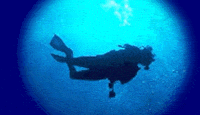|
The HMCS Saskatchewan
is British Columbia's most successful artificial reef. The popularity
of the Saskatchewan is apparent when you consider that well over
100,000 dives have been completed since she was sunk on June 14, 1997: more than all other B.C. artificial reefs put together!
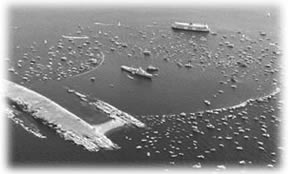 Hundreds
of boats, including a ferry that B.C. Ferries and it's crew donated
as a viewing platform, gathered just off the western side of
Snake Island, a bird sanctuary and home to over 250 harbour seals,
to watch the sinking. In just over 2 minutes the 366 foot Saskatchewan slipped below the surface and began its descent to the sandy bottom where it came to rest in 130 feet of
water with a 6 degree list to the portside. The bow faces to
the south and the stern to the north. The top of the mast is
at 45 feet and the bulk of the vessel is between 80 and 100 feet. Hundreds
of boats, including a ferry that B.C. Ferries and it's crew donated
as a viewing platform, gathered just off the western side of
Snake Island, a bird sanctuary and home to over 250 harbour seals,
to watch the sinking. In just over 2 minutes the 366 foot Saskatchewan slipped below the surface and began its descent to the sandy bottom where it came to rest in 130 feet of
water with a 6 degree list to the portside. The bow faces to
the south and the stern to the north. The top of the mast is
at 45 feet and the bulk of the vessel is between 80 and 100 feet.
Want to watch a video
of The Sinking Of The HMCS Saskatchewan? Click on the photo
above. You will require a copy of QuickTime which you
can also download from the same link. Enjoy the film!
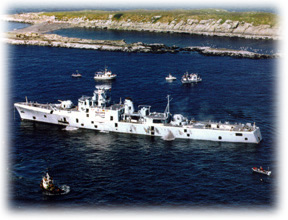 The
approximate depth to some of the most popular and identifiable
features are: The
approximate depth to some of the most popular and identifiable
features are:
Radar Platform on main mast
..........45'
Bridge .......... 65'
Top of guns .......... 85'
Fore and aft decks ..........95'
Aft mortar bay .......... 105'
Keel at bottom .......... 130'
Look at all the diver
access holes cut into the vessel. This creates lots of ambient
light and a safe diving environment for you!
The community
of Nanaimo has wholeheartedly embraced
The Saskatchewan. Our community's dedication
to diving is evident throughout Nanaimo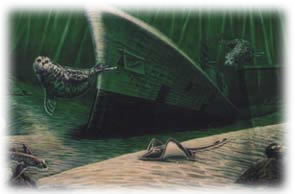 . Downtown, next to the Courthouse, the Weyerhaeuser building
boasts one of Jeff King's, Nanaimo's
renowned marine muralists', best murals. This large mural and
it's amazing detail covers the entire side of the building. Make viewing this mural a part of your
visit to Nanaimo. . Downtown, next to the Courthouse, the Weyerhaeuser building
boasts one of Jeff King's, Nanaimo's
renowned marine muralists', best murals. This large mural and
it's amazing detail covers the entire side of the building. Make viewing this mural a part of your
visit to Nanaimo.
Make Diving The Saskatchewan
part of your travel plans this year! Have a look at the great value
we offer in our Diving and Snorkeling packages!
Want to learn a bit
more of the history of The Saskatchewan, read T.W. Paterson's article
on the Noble past of The HMCS Saskatchewan:
HMCS SASKATCHEWAN
HAD A NOBLE PAST
Looking Back Article
by T.W. Paterson, Harbour City Star, February 13, 2001
"The bottom of the sea
is a funny place for a piece of Canadian prairies, but there you
have it since the sinking of HMCS Saskatchewan as an artificial
reef, in 1997.
Our second Mackenzie
class destroyer escort, she was commissioned at Esquimalt's Yarrows
Ltd., Feb. 16, 1963. At 366 feet long, with a 42-foot beam and
a displacement of 2,900 tons (fully loaded) she had a top speed
of 28 knots and a complement of 230 officers and men.
Built when Canada's
destroyers were internationally renowned as 'Cadillacs', Saskatchewan
honoured the river of that name, rather than the province, and
was the second ship of this name to serve the Royal Canadian
Navy.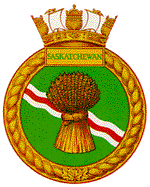
Her ship's badge shows
a sheaf of wheat imposed on a green field, with a wavy white and
rad diagonal strip denoting a river. All colours are derived from
the province of Saskatchewan's coat of arms.
Her predecessor was
commissioned in the Royal Navy in 1935 as HMS Fortune, of the Fearless
destroyer class. During the first 3½ years of the Second World
War, she steamed more than 2000,000 miles (that's eight times around
the world), participated in the Norwegian campaign and the occupation
of Iceland, and shared in the sinking of the U-27, U-24 and the
Vichy French submarine, Ajax.
While serving out of
Malta in May 1941, she was badly damaged by bombs that required
six months to repair.
In 1943, after two years
with the Eastern Fleet, Fortune was renamed Saskatchewan and transferred
to the RCN at London. She joined Escort Group C-3 after refit,
trials and workups, for convoy escort duty in the North Atlantic.
Saskatchewan and her sisters escorted no fewer than 14 convoys
in nine months until withdrawn in May, 1944 to begin special training
off Londonderry, North Ireland in preparation for the invasion
of Europe.
In June, she helped
to patrol the English Channel "as part of a barrier" to
prevent U-boats from attacking the invasion route to the Normandy
beaches.
During an offensive
patrol in the Bay of Biscay, the Canadian managed to destroy three
enemy ships and complete further patrols in British waters before
Saskatchewan was ordered back to Canada for refit in august, 1944.
She spent the last five months of the war as an escort vessel,
returned to Canada after V-E Day, and rounded out an outstanding
career as a troop transport.
Paid off for disposal
on Jan. 28, 1946, the weary destroyer was sold for scrap, leaving
three hard-won battle honours: Atlantic - 1943-1944, Normandy - 1944,
Biscay - 1944.
There's even more naval
history behind Saskatchewan than this. The only naval engagement
of the Riel Rebellion was fought on the South Saskatchewan River
(Kisikatchewan - rapid river in Cree), in 1885. Government forces
requisitioned the stern-wheel steamer Northcote, armed her with
a Gatling gun and 50 soldiers, armour-plated here with planks and
sandbags, and sent her against the rebels at Batoche.
But they riddled here
in small arms crossfire and launched another riverboat into her
path, damaging the Northcote and forcing her withdrawal.
In 1968, the latest
HMCS Saskatchewan sustained extensive damage from striking a rock
at the eastern entrance to Active Pass and again, two years later,
off Roberts Bank. Both accidents resulted in courts martial and
severe reprimands for her respective captains.
In 1997 HMCS Saskatchewan
touched sea bottom for the last time, just three km from Nanaimo.
She and several sister destroyers have been sunk as artificial
reefs and tourist attractions for divers in recent years, with
HMCS Cape Breton to soon follow."
|


